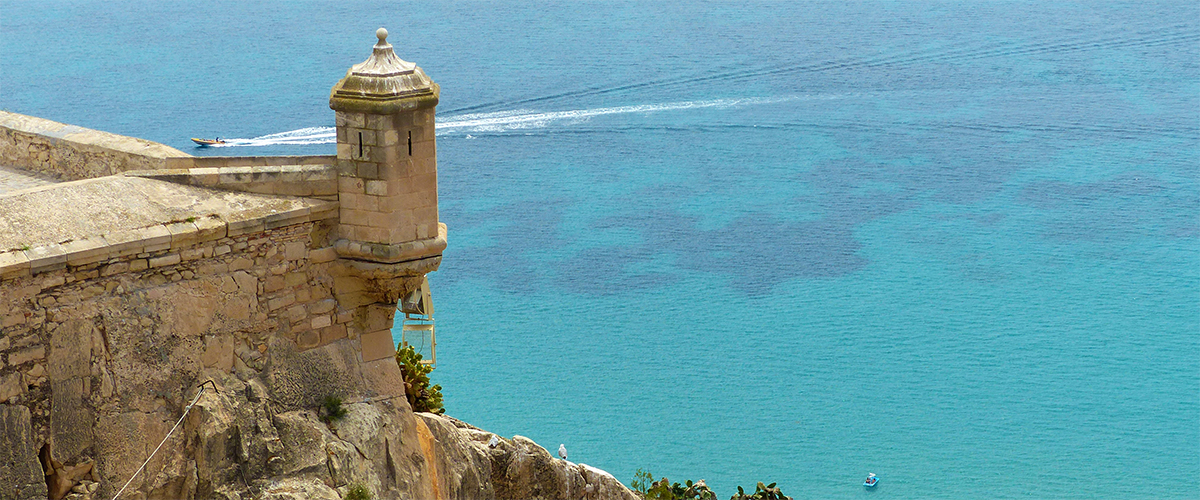Altea has established itself as the cultural and artistic epicenter of the Costa Blanca, a true haven for creators and art lovers. Its cobblestone streets, crowned by whitewashed houses and cobalt blue domes, have inspired bohemians and artists from around the world. This charming Mediterranean town not only preserves its seafaring essence but also hosts a vibrant and varied cultural offering.
Discover the magic of the castles of the Costa Blanca
Three must-see castles on the Costa Blanca: The Costa Blanca is not only synonymous with idyllic beaches and coves; it also holds a fascinating history among its hills and cities. Three castles stand out as architectural and cultural gems: the Santa Bárbara Castle in Alicante, the Atalaya de Villena and the Dénia Castle. Each one belongs to a different route and tells a unique chapter of the region's past.

Abahana Villas - Views from the Santa Bárbara Castle in Alicante.
Santa Bárbara Castle (Route of the Keys of Kingdom)
This imposing castle stands on Mount Benacantil and is one of the main attractions of Alicante. Its history dates back to the 9th century, in the middle of the Arab era, although it was renovated in the 16th century under Christian rule. For centuries, it was a strategic point for the defence of the city and also for maritime trade. Historical curiosity: During the reign of Philip II, the castle was adapted as a modern fortress, becoming one of the key points of the Mediterranean. Alicante benefited from its geographical position, facilitating the trade of salt, wines and dried fruits, products in high demand at the time.
Local recommendation: Climb the castle at sunset. From its viewing points you can enjoy a unique panoramic view of Alicante and the sea bathed in the golden tones of the sun. Also, don't miss the guided tours that tell stories about pirate attacks and daily life in the castle.
Atalaya de Villena (Route of the Castles of Alto Vinalopó)
Located in the city of Villena, this 12th-century fortress stands out for its Almohad architecture and its impressive square towers. It is an icon of the area and one of the best preserved in the province. Its main function was defensive, protecting the region from invasions and facilitating the control of trade routes.
Unique history: Legend has it that during the Reconquista, this castle was the scene of intense negotiations between Arabs and Christians. Its imposing Tower of Homage holds inscriptions in Arabic characters that narrate these encounters. Villena was known for its wealth of products such as grain and grapes, which were widely traded in the region.
Travel tip: If you visit Villena in September, you will coincide with the Moors and Christians festivals, which recreate the medieval history of the region and bring the castle back to life. You can also explore the surrounding area to discover more about the trade routes that linked this area with the rest of the peninsula.
Dénia Castle (Frontier of Fear Route)
Unlike the others, Dénia Castle has a strong maritime connection. Located in the heart of the city, it offers spectacular views of both the port and the Montgó mountain range. Built in the Islamic era and expanded in later times, it was key in Mediterranean trade thanks to its privileged location. Fun fact: During the Renaissance, this castle was the centre of an important trade network that connected Dénia with the main ports of the Mediterranean. The town was known for its production of raisins and textiles, products that reached markets as far away as Italy and North Africa.
Combine a visit to the castle with a stroll through the old town of Dénia and enjoy its gastronomic offering, famous for its red prawns. You can also visit the Archaeological Museum inside the castle, which offers a detailed insight into its commercial and seafaring past.
Vineyards grown without artificial irrigation, on sandy or calcareous soils that produce vibrant wines. The humidity of the night and the breezes of the day protect their balanced vines. Organic viticulture surrounded by almond and olive trees, a living ecosystem.

Three must-see castles on the Costa Blanca: The Costa Blanca is not only synonymous with idyllic beaches and coves; it also holds a fascinating history among its hills and cities. Three castles stand out as architectural and cultural gems: the Santa Bárbara Castle in Alicante, the Atalaya de Villena and the Dénia Castle. Each one belongs to a different route and tells a unique chapter of the region's past.
